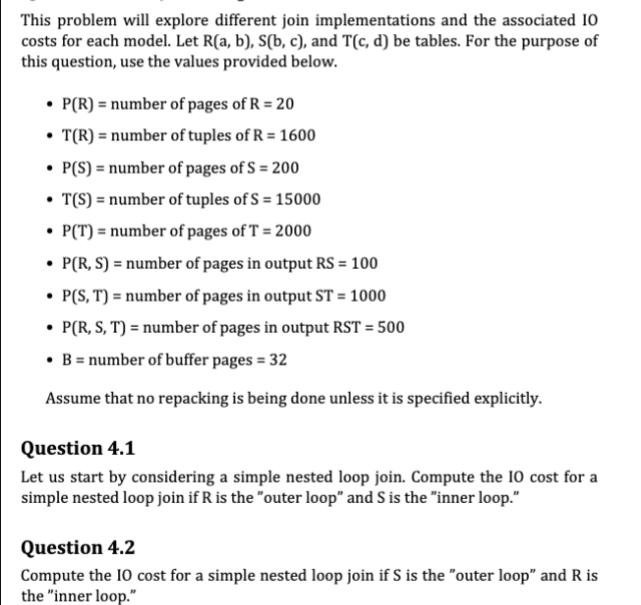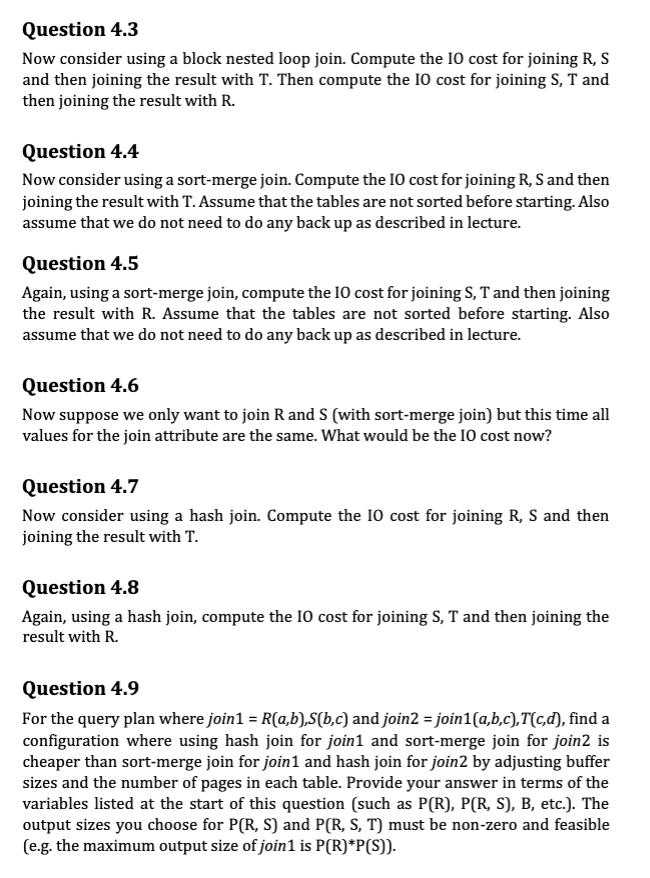Answered step by step
Verified Expert Solution
Question
1 Approved Answer
This problem will explore different join implementations and the associated 10 costs for each model. Let R(a, b), S(b, c), and T(c,d) be tables.


This problem will explore different join implementations and the associated 10 costs for each model. Let R(a, b), S(b, c), and T(c,d) be tables. For the purpose of this question, use the values provided below. P(R) = number of pages of R = 20 T(R) = number of tuples of R = 1600 P(S) = number of pages of S = 200 T(S)= number of tuples of S = 15000 P(T) = number of pages of T = 2000 P(R, S) = number of pages in output RS = 100 P(S, T) = number of pages in output ST = 1000 P(R, S, T) = number of pages in output RST = 500 B= number of buffer pages = 32 Assume that no repacking is being done unless it is specified explicitly. . . . Question 4.1 Let us start by considering a simple nested loop join. Compute the 10 cost for a simple nested loop join if R is the "outer loop" and S is the "inner loop." Question 4.2 Compute the 10 cost for a simple nested loop join if S is the "outer loop" and R is the "inner loop." Question 4.3 Now consider using a block nested loop join. Compute the 10 cost for joining R, S and then joining the result with T. Then compute the 10 cost for joining S, T and then joining the result with R. Question 4.4 Now consider using a sort-merge join. Compute the 10 cost for joining R, S and then joining the result with T. Assume that the tables are not sorted before starting. Also assume that we do not need to do any back up as described in lecture. Question 4.5 Again, using a sort-merge join, compute the 10 cost for joining S, T and then joining the result with R. Assume that the tables are not sorted before starting. Also assume that we do not need to do any back up as described in lecture. Question 4.6 Now suppose we only want to join R and S (with sort-merge join) but this time all values for the join attribute are the same. What would be the 10 cost now? Question 4.7 Now consider using a hash join. Compute the 10 cost for joining R, S and then joining the result with T. Question 4.8 Again, using a hash join, compute the 10 cost for joining S, T and then joining the result with R. Question 4.9 For the query plan where join1 = R(a,b),S(b,c) and join2 = join1(a,b,c),T(c,d), find a configuration where using hash join for join1 and sort-merge join for join2 is cheaper than sort-merge join for join1 and hash join for join2 by adjusting buffer sizes and the number of pages in each table. Provide your answer in terms of the variables listed at the start of this question (such as P(R), P(R, S), B, etc.). The output sizes you choose for P(R, S) and P(R, S, T) must be non-zero and feasible (e.g. the maximum output size of join 1 is P(R)*P(S)).
Step by Step Solution
There are 3 Steps involved in it
Step: 1
Based on the provided information lets begin by addressing Question 41 Question 41 asks us to comput...
Get Instant Access to Expert-Tailored Solutions
See step-by-step solutions with expert insights and AI powered tools for academic success
Step: 2

Step: 3

Ace Your Homework with AI
Get the answers you need in no time with our AI-driven, step-by-step assistance
Get Started


